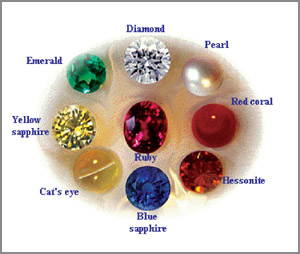|
 Gemstones
- treasures of Mother Nature Gemstones
- treasures of Mother Nature
Gemstones, or gems as referred to in day-to-day usage, are in fact
minerals. But rocks as well as organic material like amber, which are
cut and polished to be used in decorations, are also called gems.
However, gems are considered precious since they are rare and
astonishingly beautiful.
Our small country too is blessed with a considerable concentration of
invaluable gems scattered in areas such as Ratnapura, Balangoda, Elahera
and Okkampitiya. There is even historical evidence to prove that Sri
Lanka has been a centre for gems.
It is noteworthy to mention that Sri Lanka falls within the top five
nations producing gems at present. A variety of gems such as blue and
yellow sapphires, star sapphires, star rubies, moonstones and topaz are
found in Sri Lanka.
How are gems formed?
We told you that gems are minerals. Therefore, these are found in
rocks, or in gem gravels (stones mixed with sand) which have resulted
from these rocks because rocks themselves are made up of one or more
minerals.
You all know that the surface of the Earth evolves continuously and
therefore gems can be found close to the Earth's surface as well as deep
inside. Gems can be found in rivers and other waterways when the gravel
containing the gems gets washed off due to erosion.
There are three types of rocks where gemstones are found;
1. Igneous rocks
These are rocks which have solidified from molten (liquified by heat)
rocks. Initially, these lie in a molten state, deep beneath the Earth's
surface and become solid in situations like volcanic eruptions and some
even solidify beneath the Earth. beneath the Earth.
How fast the solidification happens determines the size of gemstones;
slower solidification creates larger gemstones.
2. Sedimentary rocks
These rocks are formed by the accumulation of rock fragments. As time
passes, these fragments settle down and harden into rock once again.
Sedimentary rocks are normally found in layers and sometimes the gems
found here show these layers in them.
3. Metamorphic rocks
Metamorphic rocks are either one of the above two types, which have
changed beneath the Earth due to heat and pressure and has resulted in a
new form of minerals in it. During this process, gemstones also grow
within them.
Treatments applied to gems
Gemstones are often treated to improve the colour or clarity of the
stone. Depending on the type and extent of treatment, the resulting
gemstones may have a stable colour or a colour which turns back in to
its original colour. However, this determines the value of the stone.
Following are some of the treatments used with gems:
Heat
Heat can improve the colour and clarity of gemstones. Aquamarines are
often heat-treated to remove their yellow tones, change the green colour
into the more desirable blue or enhance its existing blue colour to a
purer blue. A variety of heat treatments are used on sapphires and
rubies to improve both colour and clarity.
Radiation
Most blue topaz, both the lighter and the darker blue shades, are
exposed to radiation to change the colour from white to blue. The same
is done for green quartz to achieve the yellow-green colour.
Waxing or oiling
Emeralds containing natural cracks are sometimes filled with wax or
oil to disguise them. This wax or oil is also colorued to make the
emerald appear of better colour as well as clarity. Turquoise is also
commonly treated in a similar manner.
Fracture filling
This is all about filling up the fractures of the stone. This method
has been in use with different gemstones such as emeralds and sapphires
and also with diamonds. From 2006, 'Glass Filled Rubies' have become
popular. Rubies are generally filled with lead glass, which considerably
improves the appearance of larger rubies in particular.
Gems associated with months
January - Garnet
February - Amethyst
March - Aquamarine
April - Diamond
May - Emerald
June - Pearl or moonstone
July - Ruby
August - Peridot
September - Sapphire
October - Opal or tourmaline
November - Topaz
December - Zircon or turquoise
Artificial gem production
With developments in technology, some gemstones are being
manufactured to look like other more expensive gemstones as this is
easier than trying to find the genuine stones. For example, cubic
zirconia is an artificial diamond composed of zirconium oxide.
The speciality of these artificial stones is that although they look
like a particular gem, they do not possess their chemical or physical
characteristics.
However, this is not always the case. For example, diamonds, rubies,
sapphires and emeralds have been manufactured in labs to possess very
nearly identical chemical and physical characteristics of the original
variety.
Synthetic corundums, including ruby and sapphire, are very common and
cost only a fraction of the price of the natural stones. Larger
synthetic diamonds of gemstone quality, especially of the coloured
variety, have been manufactured quite recently.
Aravinda Dassanayake |
